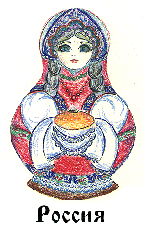
MUSIC
HOME-TSARITSINO
ABOUT SASHA
MOSCOW
VALAAM
KIZHI
AMUR RIVER
ZEYA
VALAAM
NESTING DOLL
RUSSIA: AN ENIGMA? AN ESSAY by J. Gosnell
Matrioshka dolls are also known as nesting dolls. The dolls have been a part of Russia for over one hundred years, and have come to be a symbol of the country. They seem a perfect metaphor for the mysterious, many-layered and very deep "Russian Soul". Here is one example:
There is a great love of nature, and the outdoors. A fascination with the plants and gardens. Of necessity, Russians are some of the world's finest gardeners, caring for each tiny little plant in the garden or on the windowsill. And yet in another layer; Russians care very little for the outside landscapes around their apartments and public buildings, and most courtyards are a tangle of weeds.
Winston Churchill once likened Russia itself to a Matrioshka Doll. "a riddle wrapped in a mystery inside an enigma...". An enigma. Hard to figure out. Hidden. Layers upon layers upon layers. Like the "Russian Soul" these layers can be very deep. Like a very hard winter, you have to go "deep inside" to stay warm and survive. The outer doll may symbolize a truth about the Russian character, e.g. that Russians deeply value education and science.
Many Russians are multilingual. Most are very literate. And yet, on another layer, there is a great deal of superstition within the Russian culture. This is not to condemn these beliefs (I found them fascinating) but to appreciate another complexity, another layer, another "doll" inside. The old Tsarist Russia, and indeed Soviet Russia as well (70 years of it), were well known for their secrecies. Since bureaucracy thrives in such a "secret" society, Russians still find themselves "inside the doll." They often cover their public personas with unsmiling gruffness, and yet...just inside (their own homes and dachas), one finds a caring, generous spirit of hospitality. The food contradiction: although Russia is never spoken of in terms of great cuisine, the food served in ALL the homes I visited was superb.
The causes for the "poor" food reputation were: war and political deprivation for generations. But I have met many gourmet cooks in Russian homes. The produce grown in dacha gardens and greenhouses rivals any in the world. The talented use of that produce in local home made cuisine was one of the main joys of visiting the country.
Religion in Russia is also many-layered. As I mentioned, superstition is present in even the most well-educated of citizens. A Russian doctor may sit for a few minutes before leaving the house, to avoid "bad luck."
Russians do want to live in freedom, and they do want to live in health and prosperity. However, they are more tolerant of repression than Americans, and even today, as we see the doors closing on Gorbachev's legacy of Glasnost, there is little opposition to more central control by the Kremlin.
So, you can be sure, if someone states a "fact" about the Russian culture, there will be many other "truths" inside that proclamation. Take the time to "open the doll" and look inside, and inside, and inside.
For a matrioshka coloring page, be sure to print the Matrioshka Doll on the Just for Kids page. This drawing was made by 15 year old Bashkortostan (Russia) artist Violetta, who was a foreign exchange student in my home in 1997.
There are many books about Matrioshka dolls, and you can even take classes in Russia to learn how to paint them.
Home | About Sasha | Moscow | St. Petersburg | Volga River | Kizhi | Valaam | Golden Ring | Just 4 Kids |
| Zeya| Amur |Food | Photo Shop | Russian Far East | Email Sasha | Russian Links |

